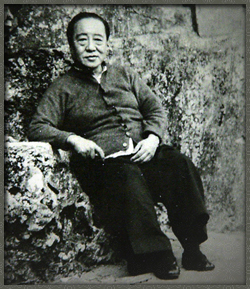|
|
||||||||||||||||||||||||||||||||||||||||||||||||||||
|
Biography of Pu Hsin-Yu Pu Hsin-Yu was born in the royal imperial Manchu family in Beijing in 1896 as a grandson of Emperor Dao-Guang (1821-1851). He was also popularly known by his style name Pu Hsin-Yu. Originally, his imperial Manchu family name was Aixinjueluo ( 愛新覺羅 ).
In 1908, Pu Ru was selected as one of the candidates to succeed the dying Emperor Guang-Hsu (1875-1909.) Dowager Express Tzu Hsi ( 慈禧太后, Pinyin: Cixi Taihou ) chose his younger cousin Pu Yi (1906 - 1967) who became the last emperor of the Ching Dynasty from 1908 to 1911. Pu Yi became the emperor when he was only three years old. He was widely known as "the Last Emperor of China ( 末代皇帝 )" between 1908 and 1924 ruling as the Xuan Tong Emperor ( 宣統皇帝 ) between 1909 and 1911, and non-ruling emperor between 1911 and 1924 under the control of other political powers and the Japanese government. As a child prodigy, Pu Hsin-Yu was good at calligraphy, literature, poetry, and various subjects. He started learning Chinese calligraphy at age four. However, he did not receive formal training in Chinese painting. Pu Ru received his undergraduate education from a university in Beijing. After graduation, in 1914, he went to continue his study at the Berlin University in Germany. In 1922, he earned his doctorate degrees both in biology and astronomy there. He then went back to China and lived a secluded life in the Je Tai Monastery at Hsi-Shan ("West Mountain") of Beijing where he further refined his arts in painting, calligraphy and poetry and studied ancient classics and history. He had a nickname of "Hermit of West Mountain ( 西山逸士 ) ". He often proclaimed that his accomplishment in painting came after his study and comprehension of the literature, classics, and history. He learned his painting skills and knowledge from the art collections of the imperial Manchu family. His works were highly honored by the Chinese people and he became one of the most respected contemporary masters in Chinese painting and calligraphy. Among all the active painters in Beijing in the 1930s and 1940s, including Chen Ban-Ding, Hu Pei-Heng, Chin Zhong-Wen, Xiao Sun, Yu Fei-An, and etc., Pu Ru was widely considered as the most accomplished artist. During the 1930s and 1940s, his fame was on a par with that of Zhang Da-Chian ( 張大千 ). When people spoke of accomplished painters, they often referred to "Zhang in the south and Pu in the north ( 南張北溥 )." He was also recognized as an accomplished poet. His works are collected in most of the museums in China and Taiwan. After the communist took over China, he moved to Taiwan in 1949. He taught at the National Taiwan Normal University and at his home studio in Taipei. He traveled extensively around Asia and gave lectures in Chinese Brush Painting during his trips. If it were not for Pu Yi and the overthrown government of the Ching Dynasty, Pu Ru could be the Emperor of China. When President Chiang Kai-Shek ( 蔣介石 ) who had previously treated Pu Hsin-Yu honorably in China asked him to teach his wife painting, he declined. So Madame Chiang Kai-Shek ( 宋美齡 ) turned to learn from Huang Jun-Bi ( 黃君壁 ) and Zheng Man-Ching ( 鄭曼青 ). When Pu Hsin-Yu was living in Taipei, his calligraphy and painting were sold at extremely high prices and could rarely be bought by the ordinary people who did not have referrals and connections. Unlike Zhang Da-Chian, he could not be easily approached and his works were not easily seen in public. His legends and anecdotes were more known in private circles, and were often told mysteriously because of his royal identity and connection with Pu Yi. He could eat extraordinary amount of food since he devoted most of his time to focus his thoughts on painting. He exercised a strong influence over painters in Taiwan. In 1954, he received an award in art from the Education Department of R.O.C. for his book on Chinese painting. In 1955, he was awarded an honorary doctor degree in art from Seoul National University. He passed away in 1963 in Taipei at the age of 68.
|
||||||||||||||||||||||||||||||||||||||||||||||||||||
|
||||||||||||||||||||||||||||||||||||||||||||||||||||



















